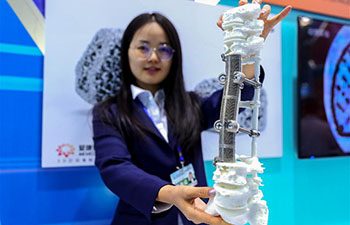CHICAGO, Oct. 10 (Xinhua) -- A multicenter study led by Washington University School of Medicine in St. Louis shows that the timing of pushing in childbirth has no effect on whether women deliver vaginally or by C-section.
The study enrolled 2,414 first-time pregnant women at one of six U.S. hospitals between May 2014 and November 2017.
The women were at least 37 weeks pregnant with a single pregnancy, and all had received epidural anesthesia to reduce labor pain.
Once the cervix was fully dilated at 10 centimeters, indicating the beginning of the second stage of labor, the women were randomly assigned to either begin pushing immediately or to delay pushing for 60 minutes.
Of those in the immediate-pushing group, 1,031 or 85.9 percent delivered vaginally compared with 1,041 or 86.5 percent in the delayed-pushing group, a difference that is not statistically significant.
"The findings provide strong evidence that for first-time pregnant women receiving epidurals, immediate versus delayed pushing during the second stage of labor did not affect vaginal delivery rates," said Menachem Miodovnik, a medical officer at the National Institutes of Health (NIH)'s Eunice Kennedy Shriver National Institute of Child Health and Human Development.
However, women in the immediate-pushing group experienced significantly lower rates of infections and fewer episodes of excessive bleeding following delivery. Specifically, 80 or 6.7 percent of the women who began pushing immediately developed an infection compared with 110 women or 9.1 percent who delayed pushing.
In addition, 27 or 2.3 percent in the immediate-pushing group suffered severe postpartum bleeding, compared with 48 or 4 percent in the delayed-pushing group.
Additionally, women who pushed immediately experienced a shorter second-stage of labor by an average of 30 minutes, compared with those who delayed pushing: which is 102.4 versus 134.2 minutes.
Although the numbers were small, infants delivered to mothers in the immediate-pushing group experienced significantly lower rates of suspected sepsis compared with those in the delayed-pushing group: 38 or 3.2 percent and 53 or 4.4 percent, respectively.
"Our findings can guide obstetric providers to better manage the second stage of labor for optimal health for moms and their babies. This means avoiding delayed pushing for the sake of increasing the chance of vaginal delivery since it is associated with longer labor time and higher health risks to mothers and babies," said the study's first author, Alison G. Cahill, Washington University associate professor of obstetrics and gynecology.
The study was published in the Journal of the American Medical Association on Tuesday.

















